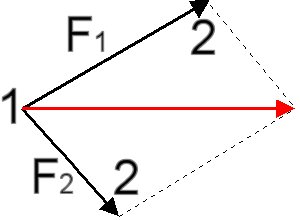|
|
||||||||||
| ||||||||||
|
|
A B C D E F G H I J K L M N O P Q R S T U V W X Y Z


The force is also described as a vectorial value, because not only its absolute amount is important. If two forces have the same (effective) direction, they can be both added or subtracted according to the value, if they are directed exactly against each other. 
If the two forces have different directions, the result is summarized through a forces-parallelogram. This is precisely how a force can be divided, if both force-directions are specified. In the above diagram, one can also see, that nothing changes, if the application point is moved along efficiency line. 
Here you can see the effect that the two forces have on the value (length) of the result. The more the two forces pull in the same direction, the greater the effect is. 08/11 
A strange experiment: The right hand vehicle has an engine, which through the winding in of the rope to the left hand vehicle, shortens the distance between the two. The question is, which vehicle moves which? 
2001-2014 Copyright programs, texts, animations, pictures: H. Huppertz - Email Translator: Don Leslie - Email: lesdon@t-online.de |
 | ||||||||
